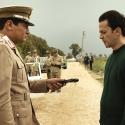China’s tumultuous recent past attempted to selectively obliterate the history of one of the world’s great and ancient civilisations, with the neatly complementary result in the past several decades of a huge upsurge in Chinese studies, East and West, from publications to exhibitions to enormous advances in archaeology. At the same time, a sense of preserving the material past has been threatened by urban development, a habit copied perhaps from the West.
And here comes a six-part television history, sprawling and ambitious, of the past 4,000 years masterminded and narrated by Michael Wood. We dash through the first 2,000 years and the founding of China in the Yellow River basin. As our guide reminded us, four great civilisations have been founded by rivers: the Euphrates, the Nile, the Indus, and the unruly and destructive Yellow River, with its unpredictable floods and propensity to cause chaos. Yet only China has survived, continuously, to be the world’s longest living culture, even its wilful attempt to destroy its own history nullified by the current embrace of capitalism. The neat little historical joke that us viewers at home might note is the irony of the timing of this television history just as China’s stock market woes rock the world (pictured below, the Dateng Gorge).
 Wood gave us a substantial hook on which to hang his unscrolling narrative: ancestor worship. The last time a Chinese Emperor worshipped at the Altar of Heaven in Beijing was in 1899, asking the ancestors for support in a ritual performed at the time of the winter solstice, at an historic turning point as the Empire crumbled under the twin threats of civil war and foreign invasion, with flood and famine to follow.
Wood gave us a substantial hook on which to hang his unscrolling narrative: ancestor worship. The last time a Chinese Emperor worshipped at the Altar of Heaven in Beijing was in 1899, asking the ancestors for support in a ritual performed at the time of the winter solstice, at an historic turning point as the Empire crumbled under the twin threats of civil war and foreign invasion, with flood and famine to follow.
More than a century on, things are quite different: a visual patchwork of jolly Chinese celebrants – Wood is never intimidated or fearful of visual and verbal cliché – were deployed to point out the reliance and survival instinct of the Chinese before we visited a massive Chinese family gathering for the spring Festival of Light, enabled by the past 30 years of the consumer society. The Ching family was meeting at Wuxi, on the Day of the Ancestor, or Tomb Sweeping Day to recall its own familial history dating from 1,000 years ago. Relatives had come from all over China, and further afield; the prosperity this implied neatly glossed over the huge rural poverty that still exists. But Wood, bouncily optimistic, and enthusiastically awestruck, declared that the Chinese, with their ancestor worship, have transcended their past as colonial subjects, emigrés and revolutionaries to acknowledge the family as the foundation: a renewed identity anchored in the Chinese past.
 There was, we are told, a kind of creation myth. Nü Wa, represented as a little dog, and her brother, Fu Xi, created humanity out of the Yellow River, and from the river’s left-over mud, formed dogs and chickens; everyone shared the same ancestors. Chinese dynasties were said to have begun more than 4,000 years ago, with the Han Chinese, then as now, the biggest tribe in the world. A traditional storyteller, mesmerised by his own dramatic tale, told his contemporary audience how King Yu, aided by the Yellow Dragon and the Black Turtle, ruled hundreds of tribes along the Yellow River, and took 13 years to tame the unruly waterway. In a 16th century temple on an ancient site, archaelogists have recently found intricate bronze bowls thousands of years old; even more remarkably, the sites of huge cities have been found, under what is now wheat fields. But the earliest Chinese state remains still a mystery, as there are no written records; but discoveries have proceeded apace, including a royal burial with a sceptre in the form of a dragon made of 2,000 pieces of turquoise (pictured above, farmers near Erlitou).
There was, we are told, a kind of creation myth. Nü Wa, represented as a little dog, and her brother, Fu Xi, created humanity out of the Yellow River, and from the river’s left-over mud, formed dogs and chickens; everyone shared the same ancestors. Chinese dynasties were said to have begun more than 4,000 years ago, with the Han Chinese, then as now, the biggest tribe in the world. A traditional storyteller, mesmerised by his own dramatic tale, told his contemporary audience how King Yu, aided by the Yellow Dragon and the Black Turtle, ruled hundreds of tribes along the Yellow River, and took 13 years to tame the unruly waterway. In a 16th century temple on an ancient site, archaelogists have recently found intricate bronze bowls thousands of years old; even more remarkably, the sites of huge cities have been found, under what is now wheat fields. But the earliest Chinese state remains still a mystery, as there are no written records; but discoveries have proceeded apace, including a royal burial with a sceptre in the form of a dragon made of 2,000 pieces of turquoise (pictured above, farmers near Erlitou).
Chinese writing, recognisable today, but dating from 1200 BC, was dramatically found by a scholar in 1899. Ill with malaria, the traditional pharmacy sent him so-called dragon bones, which bore scratchings which he realised were pictographs. In a valley of the Yellow River huge tombs have been uncovered, containing mass human sacrifices, with texts written on oracle bones. Even in the midst of 1930s civil war and the Japanese invasion, archaeology continued, with discoveries from the Bronze Age found 30 metres down in Yellow River silt.
We were introduced to the primacy of Daoism, the earliest religion, and reminded of the extraordinary worldwide zeitgeist of the 6th century BC, the time of the Old Testament, Buddhism, Greek philosophy – and Confucius. The book of his teachings, the Analects, remains perhaps one of the most influential documents of all time, teaching morality and correct behaviour, based on the doing of good deeds, the importance of law and good governance, general courtesy, respect for family. The Red Guards smashed his tomb, which has been painstakingly constructed, and is endlessly visited: we shared our viewing with a finely costumed delegation from South Korea (pictured below). A bookstall provided piles of the popular edition of the Analects, the little blue book, which everyone knows, and which has – we infer – neatly supplanted Mao’s Little Red Book.
 We raced through successive dynasties, visiting the burial mounds containing most famously the terracotta warriors – some 200 pits have so far been uncovered – of the Qin dynasty, the first centralised bureaucracy of the Chinese state 2,200 years ago, ruling 30 million people, a third of the world. Our last stop in this first instalment was the Han (206 BC – 220 AD) who overthrew the Qin, and further unified the Chinese state.
We raced through successive dynasties, visiting the burial mounds containing most famously the terracotta warriors – some 200 pits have so far been uncovered – of the Qin dynasty, the first centralised bureaucracy of the Chinese state 2,200 years ago, ruling 30 million people, a third of the world. Our last stop in this first instalment was the Han (206 BC – 220 AD) who overthrew the Qin, and further unified the Chinese state.
Wood has given us a fascinating visual essay, taking us to archaeological sites in the heart of China, and introducing many an unfamiliar town and city, far from the usual Beijing and Shanghai, and elucidating perhaps inadvertently how very different China was and is from the West, however familiar its cityscape of contemporary skyscrapers may seem to be. The story is to be continued: but our ebullient guide concluded by suggesting that China now saw a belief in history as a source of strength not weakness, with a tripartite emphasis on the state, the family, and the ancestors, and that present-day Chinese had confidence in an expansive future, generation to generation. Hmmm…















Add comment